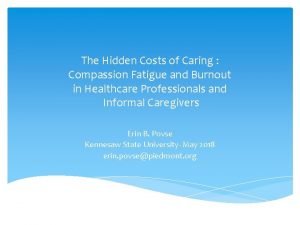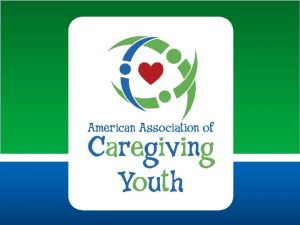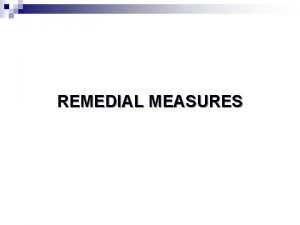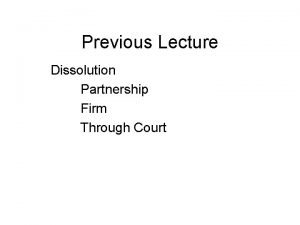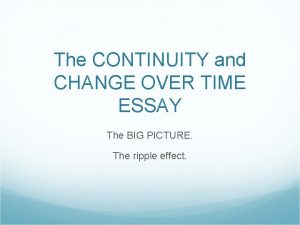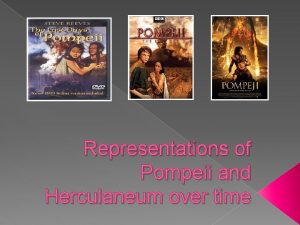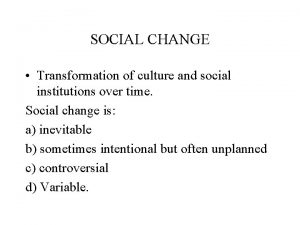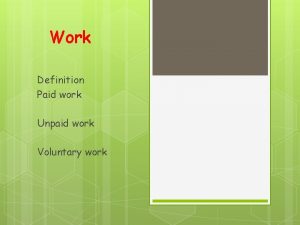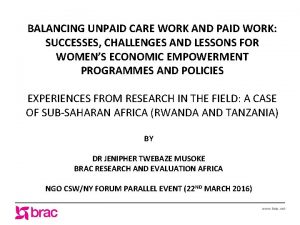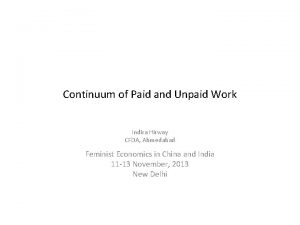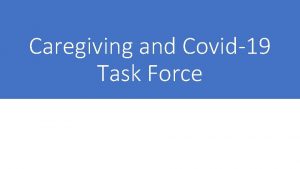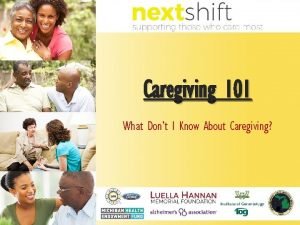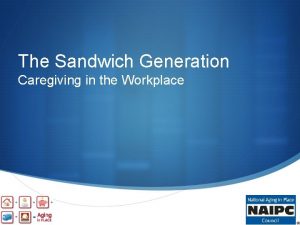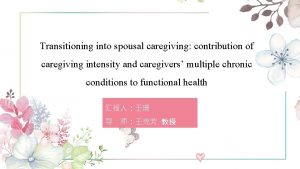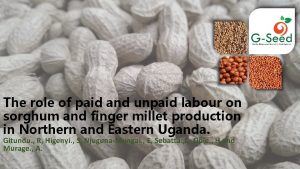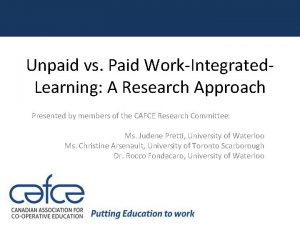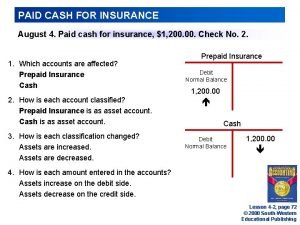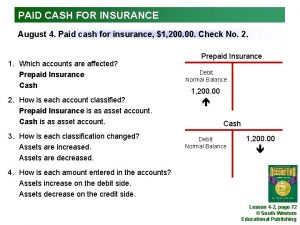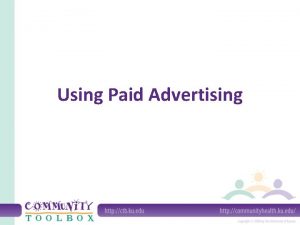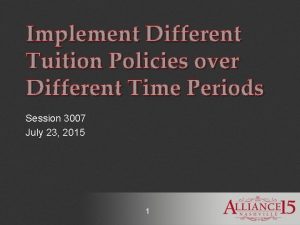Unpaid caregiving paid work and over time different























- Slides: 23

Unpaid caregiving & paid work and over time: different pathways, divergent outcomes and the role of social attitudes Fiona Carmichael and Marco Ercolani University of Birmingham 2015

Aims, summary of results and context Data and Methods Caregiving-employment pathways Characteristics of people following different trajectories 5. Wealth, health and wellbeing outcomes 6. Summary 1. 2. 3. 4. 2

§ Aims § Persistence and interdependence: Categorise the different ways people combine paid work, informal caring and childcare responsibilities over time. § Pre-determination: Explore how gender, age-cohort and social attitudes shape the pathways that people follow § Diverging/converging outcomes ~ Path dependence: Investigate how income, subjective wellbeing and health evolve along different employment-caregiving pathways. § Summary of Results § Persistence/interdependence: 5 clusters of employment- caregiving pathways over 15 -20 yrs § Pre-determination: Employment-caregiving histories are preshaped by gender, age and social attitudes. § Path dependence: Income, wellbeing and health gaps between least and most caring intensive pathways widen 3

Context § Demographic Ageing § Pensions crisis § Working lives extended +increasing female employment participation § Increase in degenerative diseases (e. g. dementia) + emphasis on costcontainment and efficiency in healthcare. § Increased demand for informal care for older adults Policy issue/question § Will the supply of unpaid care meet increased demand? § “understanding what motivates the provision of caring labor is a crucial element for sustainability and equitably meeting the needs of contemporary societies” Adams and Sharp 2013: 101 4

Social norms & attitudes Individual-familyhousehold ‘rational’ choices • Constrained choices • Responsibility, duty/obligation • Reciprocity in social relationships • Relational contexts -altruism, affection, love • Life contexts matter and have life-course implications • Time allocation to paid work and ‘productive but costly’ caregiving • Efficient choices at a moment in time → comparative (dis)advantages in future decisions • Caregiving costs/burden matter PRE-DETERMINATION, PERSISTENCE, PATH DEPENDENCE 5

§ Data: 20 waves of the British Household Panel Survey + UK Understanding Society (BHPS-US). § 4339 Caregiving-employment sequences over 15 -20 yrs § § Methods Persistence: 5 Pathways identified using OM and clustering (Brzinsky-Fay et al. 2006; Potârcӑ et al. 2014) 2. Pre-determination: MNL Regression analysis to identify characteristics of people following pathways: § Gender, age-cohort, attitudes, income, health and wellbeing 3. Diverging outcomes: Difference in differences analysis 1. § Income, wellbeing and health, baseline-follow-up outcomes for the 5 clusters (~ control and treated) 6

§ 3 Employment status: (i) Employed full-time (FT work); (ii) Employed part-time (PT work); (iii) Not Employed; (iv) Student. § 3 Informal care status: (i) Not undertaking informal care (IC=0); (ii) Caring for less than 20 hours a week (IC<20 hrs); (iii) Caring at least 20 hours a week (IC>=20 hrs). “Is there anyone living with you who is sick, handicapped or elderly whom you look after or give special help to (for example, a sick or handicapped (or elderly) relative/ husband/ wife/ friend, etc)? ” “Do you provide some regular service or help for any sick, handicapped or elderly person not living with you? ” § 2 Responsibility for young children: (i) Child aged seven or younger in household (Has child<8); (ii) No child aged seven or younger in household (No child<8). § 23 interacted states but because of small numbers use 13 7

Observed state Frequency Percent 1 FT work, IC=0, No child<8 27, 491 33. 7 2 FT work, IC=0, Has child<8 3 FT work, IC<20 hrs 5, 573 4, 239 6. 83 5. 2 436 0. 53 7, 327 2, 708 1, 959 8. 98 3. 32 2. 4 333 0. 41 9 Student 10 Not Employed, IC=0, No child<8 1, 567 21, 042 1. 92 25. 8 11 Not Employed, IC=0, Has child<8 12 Not Employed, IC<20 hrs 2, 650 4, 296 3. 25 5. 27 13 Not Employed, IC>=20 hrs 1, 943 2. 38 4 FT work, IC>=20 hrs 5 PT work, IC=0, No child<8 6 PT work, IC=0, Has child<8 7 PT work, IC<20 hrs 8 PT work, IC>=20 hrs 81, 564 Total Caregiving = 16. 19% (16. 35% including student carers) of states 100 8

State distribution plot for the whole sample child<8 IC IC 9

State distribution plot by age cohort ~ synthetic life cycle 10

State distribution plot by gender 11

1. 2 Clustering the sequences 12

Cluster No. of caregiving states % of all caregiving states > 20 hrs 1 FT careers 2 Evolving careers 3 PT careers 4 Caring intensive 1, 840 2, 854 2, 601 13. 79 21. 40 19. 50 5. 14 8. 85 19. 75 4, 447 33. 34 54. 99 5 Decaying careers 1, 597 11. 27 total 100. 00 13, 339 13

14

Cluster 2 Evolving careers Cluster 3 Part-time careers Cluster 4 Caring intensive Cluster 5 Decaying careers 1. 01** 0. 98*** 0. 98* FEMALE 1. 27** ms_Mar. Coh. Civ 1. 92*** High. Q Degree 0. 97 High. Q_Other. H 0. 88 High. Q_ALevel 0. 96 High. Q_OLevel 1. 36** Pathways are A 1: Traditional_Gender_Roles 1. 06 age-cohort A 2: Traditonal_Family 1. 05 A 3: Working_Women (life-cycle) 0. 95 Income_Tot dependent 0. 98*** GHQ_Wellbeing 0. 99 Health_status 1. 08 1. 00 0. 98*** 0. 99 1. 01* 15. 9*** 2. 13*** 1. 16 0. 80 0. 77 0. 83 1. 22*** 1. 20*** 0. 83*** 0. 94*** 0. 98 0. 91 1. 02** 1. 03*** 1. 06*** 1. 10*** 3. 77*** 1. 67*** 0. 78 0. 81 1. 23*** 1. 33*** 0. 84** 0. 96*** 0. 97* 0. 74*** 1. 07*** 1. 06*** 1. 11*** 1. 13*** 3. 60*** 0. 82 0. 76 0. 51*** 0. 73 0. 76 1. 17** 1. 28*** 0. 81*** 0. 95*** 0. 99 0. 60*** 0. 42*** 0. 23*** 0. 18*** MNL dependent = CLUSTER Base category – Cluster 1 Age*Trailing-edge_BB Age*Leading-edge_BB Age*Post-depression_pre. BB Age*Pre-depression_pre. BB Constant Observations Log likelihood , LR χ2 , Pseudo R 2 0. 85 -4459. 59 4105 3942. 28*** 0. 3065 15

Cluster 2 Evolving careers Cluster 3 Part-time careers Cluster 4 Caring intensive Cluster 5 Decaying careers Age*Trailing-edge_BB Age*Leading-edge_BB Age*Post-depression_pre. BB Age*Pre-depression_pre. BB 1. 01** 0. 98*** 0. 98* 1. 00 0. 98*** 0. 99 1. 01* 1. 02** 1. 03*** 1. 06*** 1. 10*** 1. 07*** 1. 06*** 1. 11*** 1. 13*** FEMALE 1. 27** 15. 9*** 3. 77*** 3. 60*** ms_Mar. Coh. Civ High. Q_Degree High. Q_Other. H High. Q_ALevel High. Q_OLevel 1. 92*** 0. 97 0. 88 0. 96 1. 36** 2. 13*** 1. 16 0. 80 0. 77 0. 83 1. 67*** 0. 78 0. 81 0. 82 0. 76 0. 51*** 0. 73 0. 76 1. 05 0. 95 1. 22*** 1. 20*** 0. 83*** 1. 23*** 1. 33*** 0. 84** 1. 17** 1. 28*** 0. 81*** 0. 98*** 0. 99 1. 08 0. 94*** 0. 98 0. 91 0. 96*** 0. 97* 0. 74*** 0. 95*** 0. 99 0. 60*** MNL dependent = CLUSTER Base category – Cluster 1 A 1: Traditional_Gender_Roles A 2: Traditonal_Family A 3: Working_Women Income_Tot GHQ_Wellbeing Health_status Constant Observations Log likelihood , LR χ2 , Pseudo R 2 Pathways are pre-determined by 4105 -4459. 59 3942. 28*** 0. 3065 gender and social attitudes 16

MNL dependent = CLUSTER Base category – Cluster 1 Age*Trailing-edge_BB Age*Leading-edge_BB Age*Post-depression_pre. BB Age*Pre-depression_pre. BB FEMALE ms_Mar. Coh. Civ High. Q_Degree High. Q_Other. H High. Q_ALevel High. Q_OLevel A 1: Traditional_Gender_Roles A 2: Traditonal_Family A 3: Working_Women Income_Tot GHQ_Wellbeing Health_status Constant Observations, Log likelihood , LR χ2 , Pseudo R 2 Cluster 2 Evolving careers Cluster 3 Part-time careers Cluster 4 Caring intensive Cluster 5 Decaying careers 1. 01** 1. 00 1. 02** 1. 07*** 0. 98*** 1. 03*** 1. 06*** 0. 98*** 0. 99 1. 06*** 1. 11*** 0. 98* 1. 01* 1. 10*** 1. 13*** Cluster 1 are richer than the rest 1. 27** 15. 9*** 3. 77*** 3. 60*** 1. 92*** 2. 13*** 1. 67*** 0. 82 from the start, healthier than 0. 97 1. 16 0. 78 0. 76 Clusters 4 -5 and marginally 0. 88 0. 80 0. 78 0. 51*** happier than Cluster 4 0. 96 0. 77 0. 81 0. 73 1. 36** 0. 83 0. 81 0. 76 1. 06 1. 22*** 1. 23*** 1. 17** 1. 05 1. 20*** 1. 33*** 1. 28*** 0. 95 0. 83*** 0. 84** 0. 81*** 0. 98*** 0. 99 1. 08 0. 94*** 0. 98 0. 91 0. 85 0. 42*** 4105 -4459. 59 0. 96*** 0. 95*** 0. 97* 0. 99 0. 74*** 0. 60*** 0. 23*** 3942. 28*** 17 0. 18*** 0. 3065

Income. Tot = β 0 + βL LAST_yr + Σβi CLUSTERj + Σβj CLUSTERj*LAST_yr + Σβn. Xn (1) . GHQ_Wellbeing=β 0 + βL LAST_yr + Σβi CLUSTERj + Σβj CLUSTERj*LAST_yr +Σβn. Xn (2) LAST_yr = 1 for the last, ‘follow-up’ year; = 0 for the first, Health = β 0 + βL LAST_yr + Σβi CLUSTERj + Σβj CLUSTERj*LAST_yr + Σβn. Xn ‘baseline’, year (3) CLUSTERj = 1 for ‘treated’ Clusters 2 -5; Cluster 1 = ‘control’ CLUSTERj*LAST_yr interacts CLUSTERj and the last, followup, year of the sequence → difference-in-differences effects 18

Difference in differences Income_Tot GHQ_Wellbeing Health LAST_yr 4. 01*** -0. 69*** -0. 26*** -3. 25*** -5. 93*** -4. 23*** -5. 15*** 2. 05*** -2. 39*** -4. 99*** -2. 87*** -0. 14 -0. 45* -1. 17*** -0. 93*** -0. 22 -0. 16 -0. 98** -0. 71** 0. 013*** 0. 0052 -0. 14*** -0. 17*** -0. 26*** -0. 0059 0. 094* -0. 24*** -0. 25*** 0. 0048*** 23. 8*** 8, 371 0. 041, 17. 00*** 2. 55*** 8, 525 0. 130, 60. 57*** Cluster 2 (Evolving) Cluster 3 (Part-time) Cluster 4 (Caring Intensive) Cluster 5 (Decaying) Cluster 2_LAST_yr Cluster 3_LAST_yr Cluster 4_LAST_yr Cluster 5_LAST_yr Income_Tot GHQ_Wellbeing Health_status Age-cohort, gender etc. Constant Observations R-squared , F 0. 021 1. 15*** 7. 78*** 8, 124 0. 292, 151. 82*** Coefficients Constant + LAST_yr = mean outcome Cluster 1, follow-up year 19

Difference in differences Income_Tot GHQ_Wellbeing Health LAST_yr Cluster 2 (Evolving) Cluster 3 (Part-time) Cluster 4 (Caring Intensive) Cluster 5 (Decaying) 4. 01*** -3. 25*** -5. 93*** -4. 23*** -5. 15*** -0. 69*** -0. 14 -0. 45* -1. 17*** -0. 93*** -0. 26*** 0. 0052 -0. 14*** -0. 17*** -0. 26*** Cluster 2_LAST_yr Cluster 3_LAST_yr Cluster 4_LAST_yr Cluster 5_LAST_yr 2. 05*** -2. 39*** -4. 99*** -2. 87*** -0. 22 -0. 16 -0. 98** -0. 71** -0. 0059 0. 094* -0. 24*** -0. 25*** Coefficients CLUSTERj (j=2 -4) → differences between Cluster 1 and each of ‘treated’ Clusters 2 to 5, at the baseline 20

Difference in difference Income_Tot GHQ_Wellbeing Health LAST_yr Cluster 2 (Evolving) Cluster 3 (Part-time) Cluster 4 (Caring Intensive) Cluster 5 (Decaying) 4. 01*** -3. 25*** -5. 93*** -4. 23*** -5. 15*** -0. 69*** -0. 14 -0. 45* -1. 17*** -0. 93*** -0. 26*** 0. 0052 -0. 14*** -0. 17*** -0. 26*** Cluster 2_LAST_yr Cluster 3_LAST_yr Cluster 4_LAST_yr Cluster 5_LAST_yr 2. 05*** -0. 22 -0. 0059 -2. 39*** -0. 16 0. 094* -4. 99*** -0. 98** -0. 24*** -2. 87*** -0. 71** -0. 25*** Coefficients of Clusterj_LAST_yr → difference-indifference (impact) of Cluster 2 -5 pathways over 15 -20 years (baseline →follow-up) 21

§ Persistence: 5 distinct employment-caregiving pathways § 1. Full-time careers; 2. Evolving careers; 3. Part-time careers; 4. Caring intensive; 5. Decaying careers § Pre-determination: Age-cohort, gender & social attitudes shape trajectories § E. g. more traditional attitudes towards gender roles, family and working women → clusters 3, 4 and 5 § Diverging/converging outcomes ~ cumulative (dis)advantage & path dependence: Some income, wellbeing and health gaps widen others narrow –) § Cluster 2: income gap with Cluster 1 narrows § Cluster 3: poorer but healthier relative to Cluster 1 – work-life balance? § Cluster 4: much poorer, much lower wellbeing, worse health - Caregiver burden (Adelman et al. 2014)? § Cluster 5: relatively poorer and much lower health status 22

§ The data § Only 15 -20 years § Some lack of consistency between BHPS and US § Sample attrition § Alternatives: retrospective life history data, time-use data § The methods § Discretion over substitution penalties and number of clusters (Halpin, 2010; Piccarreta 2012; Potârcӑ et al. , 2013) § Advantage: Retains the sequential character of lifehistories as entities while enabling grouping of all different sequence element combinations § ‘just about fishing for patterns’ Potârcă et al. (2013: 81) 23
 Compassion fatigue vs burnout
Compassion fatigue vs burnout American association of caregiving youth
American association of caregiving youth Unpaid balance method
Unpaid balance method Unpaid seller section 45
Unpaid seller section 45 Unpaid voucher file
Unpaid voucher file What is unpaid advertising
What is unpaid advertising How do the twelve tables resolve unpaid debts
How do the twelve tables resolve unpaid debts Introduction of unpaid seller
Introduction of unpaid seller Paid drawing. it be work millions.
Paid drawing. it be work millions. Work today get paid tomorrow
Work today get paid tomorrow Start time, end time and elapsed time
Start time, end time and elapsed time Siach reciting the word over and over
Siach reciting the word over and over Taking over navigational watch
Taking over navigational watch Over the mountain over the plains
Over the mountain over the plains Chapter 4 section 1 work and machines answer key
Chapter 4 section 1 work and machines answer key Change and continuity thesis example
Change and continuity thesis example Pompeii logo
Pompeii logo Transformation of culture and social institutions over time
Transformation of culture and social institutions over time Why do different polymers have different properties
Why do different polymers have different properties Why do different atoms produce different colors
Why do different atoms produce different colors Sound will travel at different speeds in different mediums.
Sound will travel at different speeds in different mediums. Library thinkquest org 19537
Library thinkquest org 19537 Different culture have different moral codes
Different culture have different moral codes Different angle different story
Different angle different story
